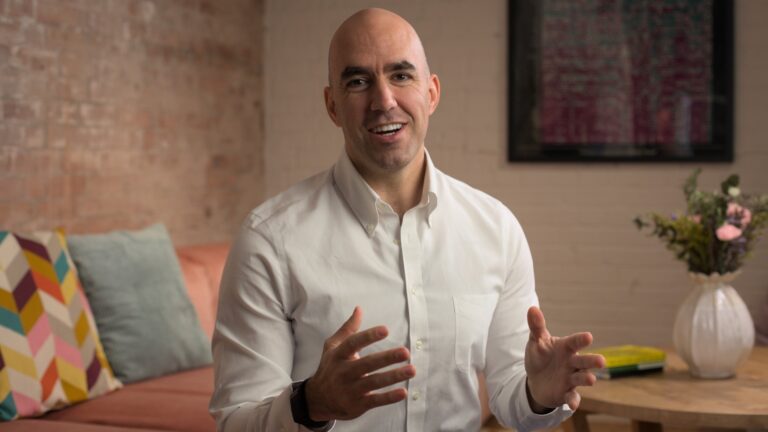Season 5: Innovating for impact
The time is now to embrace innovation

Creating a business that stands out and makes a meaningful impact begins with the foundational principle of thinking outside the box and genuinely addressing a need. Rather than replicating existing models or solutions, many successful entrepreneurs embark on a journey of innovation to identify unmet needs or overlooked challenges in the market.
In the final part of my masterclass, we’ll look at how this mindset of thinking creatively and critically about certain problems can set the stage for developing unique solutions that genuinely resonate with customers.
Set out to make a difference, and innovation will follow
At Canva, our founders set out to tackle the fragmented design ecosystem that was home to hundreds of complex tools. They recognised the need to democratise design and created Canva to allow anyone and everyone, regardless of their design experience, to be able to create something beautiful.
Fast forward a decade and our product has evolved to meet the needs of not just social media managers, but large businesses, non-profits and educational institutions.
When driven by a mission to make a real difference and positive contribution to the world, innovation becomes an organic outcome of the process. When companies focus on solving meaningful problems, individuals and organisations naturally gravitate towards innovative solutions that have a lasting impact.
Think like an entrepreneur and strive for simplicity
The first step is to conduct thorough market research. Yes – market research. Sounds basic, doesn’t it? But by understanding the landscape you operate in, identifying gaps or inefficiencies and listening to the feedback of potential users, you can pinpoint specific needs that demand innovative solutions. It’s not just about creating a product or service; it’s about crafting a solution that truly addresses and solves a problem faced by the target audience.
Outside of work I’m an active investor and entrepreneur myself – I’ve built and sold two businesses in the past, Gigzone and Olapic. I’m also a mentor. So my thinking here doesn’t come from nowhere; it’s from listening to many entrepreneurs from businesses of varying sizes, and understanding how they discovered their “why” – why they set out to do what they did.
One thing they share is the ability to think outside the box. This requires a willingness to question and challenge conventional wisdom – how something has always been done, for example – and explore a new or different approach. These entrepreneurs are often the ones who bring disruptive innovations to the market. This mindset is not about reinventing the wheel but about reimagining how the wheel can function more efficiently or serve a different purpose altogether.
Creating a business with a focus on solving a genuine need requires passion, persistence and a deep understanding of the target audience. It’s about more than just profitability; it’s about making a positive impact on people’s lives. By staying true to this vision and consistently challenging the norm, entrepreneurs can forge a path of innovation that sets their business apart and positions it for long-term success in a competitive market.
Meeting your new idea with new technologies
The rapid advancements in technology provide unprecedented opportunities to disrupt traditional business models and create unique value propositions. These days we can all access and use cutting-edge tools, such as artificial intelligence, data analytics and digital platforms, to streamline operations, enhance customer experiences and gain a competitive edge.
From online marketplaces to personalised AI-driven solutions, integrating new technologies allows businesses to tap into unexplored markets and meet evolving consumer demands. Successful entrepreneurs recognise the transformative potential of these technologies, viewing them not just as tools but as enablers of innovation that can redefine industries and propel ventures to new heights.
In my role at Canva, I work closely with business leaders of large enterprises. With over 90% of Fortune 500 companies using Canva now, our product is being implemented in organisations ranging from financial services to education institutions. We know that our customers are longing for simplicity over complexity when it comes to managing tools; business leaders want to achieve more with less – and quickly. We’ve seen first-hand how our AI tools are having a positive impact in the workplace, whether that’s for an individual, a startup or larger enterprise.
Being innovative means constant improvement
The success of a business rooted in innovation lies in its commitment to continuous improvement. Adaptability and a willingness to iterate on ideas are essential components of a successful business. We must remain open to feedback, actively seek opportunities for refinement, and be agile in adapting strategies based on changing market dynamics.
TRY THIS:
So now, it’s over to you! Remember when I told you about our founders’ original mission to democratise design and allow anyone to create something beautiful, without having to worry about all the complex tools out there? Are you clear about what your company is trying to change, or the solution it’s offering people? It might be a good time to revisit or redefine that and share it with your team members.
Then have a look at your technology – all the way from the systems you use to converse with colleagues, to the applications you have on hand to streamline work and those you make or use to help you deliver on your mission. Challenge yourself to conduct a comprehensive review of your workplace technologies. Assess whether the current tools you use are in alignment with your company goals and foster innovation. Identify areas where technological updates or enhancements are needed to create a smarter and more adaptive work environment.
So as my masterclass on comes to a close, I’d like you to reflect on the things we’ve discussed – from having a business built on solid foundations so you can experiment and innovate, to customer zero and inviting the people you work with to provide honest and insightful feedback on your product or service. And finally, embrace the challenge of revising technologies to ensure they not only streamline daily operations but also contribute to a culture of innovation within your workplace.


